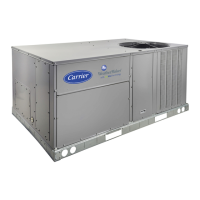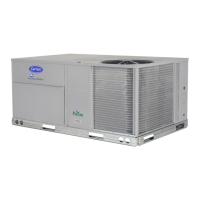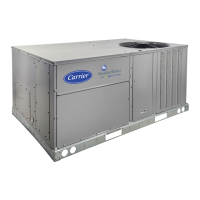61
ECONOMIZER FAULT DETECTION AND DIAGNOSTICS
(FDD) CONTROL
The Economizer Fault Detection and Diagnostics control can
be divided into two tests:
• Test for mechanically disconnected actuator
• Test for stuck/jammed actuator
Mechanically Disconnected Actuator
The test for a mechanically disconnected actuator will be per-
formed by monitoring SAT as the actuator position changes
and the damper blades modulate. As the damper opens, it is ex-
pected SAT will drop and approach OAT when the damper is at
100%. As the damper closes, it is expected SAT will rise and
approach RAT when the damper is at 0%. The basic test will be
as follows:
1. With supply fan running take a sample of SAT at current ac-
tuator position.
2. Modulate actuator to new position.
3. Allow time for SAT to stabilize at new position.
4. Take sample of SAT at the new actuator position and deter-
mine if the damper has opened or closed. If damper has
opened, SAT should have decreased. If damper has closed,
SAT should have increased.
5. Use current SAT and actuator position as samples for next
comparison after next actuator move.
The control will test for a mechanically disconnected damper if
all the following conditions are true:
1. An economizer is installed.
2. The supply fan is running.
3. Conditions are good for economizing.
4. The difference between RAT and OAT is greater than
T24RATDF. It is necessary for there to be a large enough dif-
ference between RAT and OAT in order to measure a change
in SAT as the damper modulates.
5. The actuator has moved at least T24ECSTS %. A very small
change in damper position may result in a very small (or
non-measurable) change in SAT.
6. At least part of the economizer movement is within the range
T24TSTMN% to T24TSTMX%. Because the mixing of
outside air and return air is not linear over the entire range of
damper position, near the ends of the range even a large
change in damper position may result in a very small (or
non-measurable) change in SAT.
Furthermore, the control will test for a mechanically discon-
nected actuator after T24CHDLY minutes have expired when
any of the following occur (this is to allow the heat/cool cycle
to dissipate and not influence SAT):
1. The supply fans switches from OFF to ON.
2. Mechanical cooling switches from ON to OFF.
3. Reheat switches from ON to OFF.
4. The SAT sensor has been relocated downstream of the heat-
ing section and heat switches from ON to OFF.
The economizer will be considered moving if the reported po-
sition has changed at least ± T24ECMDB %. A very small
change in position will not be considered movement.
The determination of whether the economizer is mechanically
disconnected will occur SAT_SEC/2 seconds after the econo-
mizer has stopped moving.
The control will log a “damper not modulating” alert if:
1. SAT has not decreased by T24SATMD degrees F SAT_SET/
2 seconds after opening the economizer at least
T24ECSTS%, taking into account whether the entire move-
ment has occurred within the range 0 to T24TSTMN%.
2. SAT has not increased by T24SATMD degrees F SAT_SET/
2 seconds after closing the economizer at least
T24ECSTS%, taking into account whether the entire move-
ment has occurred within the range T24TSTMX to 100%.
3. Economizer reported position 5% and SAT is not approxi-
mately equal to RAT. SAT not approximately equal to RAT
will be determined as follows:
a. SAT<RAT-(2*2(thermistor accuracy) + 2 (SAT
increase due to fan)) or
b. SAT>RAT+(2*2(thermistor accuracy) + 2 (SAT
increase due to fan))
4. Economizer reported position 95% and SAT is not approxi-
mately equal to OAT. SAT not approximately equal to OAT
will be determined as follows:
a. SAT<OAT-(2*2(thermistor accuracy) + 2 (SAT
increase due to fan)) or
b. SAT>OAT+(2*2(thermistor accuracy) + 2 (SAT
increase due to fan))
The control will test for a jammed actuator as follows:
• If the actuator has stopped moving and the reported posi-
tion (ECONOPOS) is not within ± 3% of the commanded
position (ECONOCMD) after 20 seconds, a “damper stuck
or jammed” alert will be logged.
• If the actuator jammed while opening (i.e., reported posi-
tion is less than the commanded position), a “not econo-
mizing when it should” alert will be logged.
• If the actuator jammed while closing (i.e., reported posi-
tion is greater than the command position), the “economiz-
ing when it should not” and “too much outside air” alerts
will be logged.
The control will automatically clear the jammed actuator alerts
as follows:
• If the actuator jammed while opening, when ECONOPOS
is greater than the jammed position the alerts will be
cleared.
• If the actuator jammed while closing, when ECONOPOS <
jammed position the alerts will be cleared.
DIFFERENTIAL DRY BULB CUTOFF CONTROL (DIF-
FERENTIAL DRY BULB CHANGEOVER)
As both return air and outside air temperature sensors are in-
stalled as standard on these units, select this option, E.SEL = 1,
to perform a qualification of return and outside-air in the en-
abling/disabling of free cooling. If this option is selected the out-
side-air temperature will be compared to the return-air tempera-
ture to disallow free cooling as shown below:
The status of differential dry bulb cutoff will be visible under
Run Status
ECON
DISA
DDBC.
There will be hysteresis where OAT must fall 1°F lower than
the comparison temperature when transitioning from DDBC-
STAT=YES to DDBSTAT=NO.
E.SEL
(ECON_SEL)
DDB.C
(EC_DDBCO
OAT/RAT
Comparison
DDBC
(DDBCSTAT)
NONE,
OUTDR.ENTH,
DIF.ENTHALPY
N/A N/A NO
DIFF.DRY BULB
0 deg F OAT>RAT YES
OATRAT NO
–2 deg F OAT>RAT-2 YES
OATRAT-2 NO
–4 deg F OAT>RAT-4 YES
OATRAT-4 NO
–6 deg F OAT>RAT-6 YES
OATRAT-6 NO
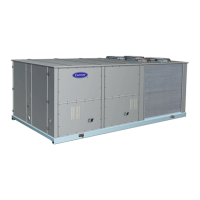
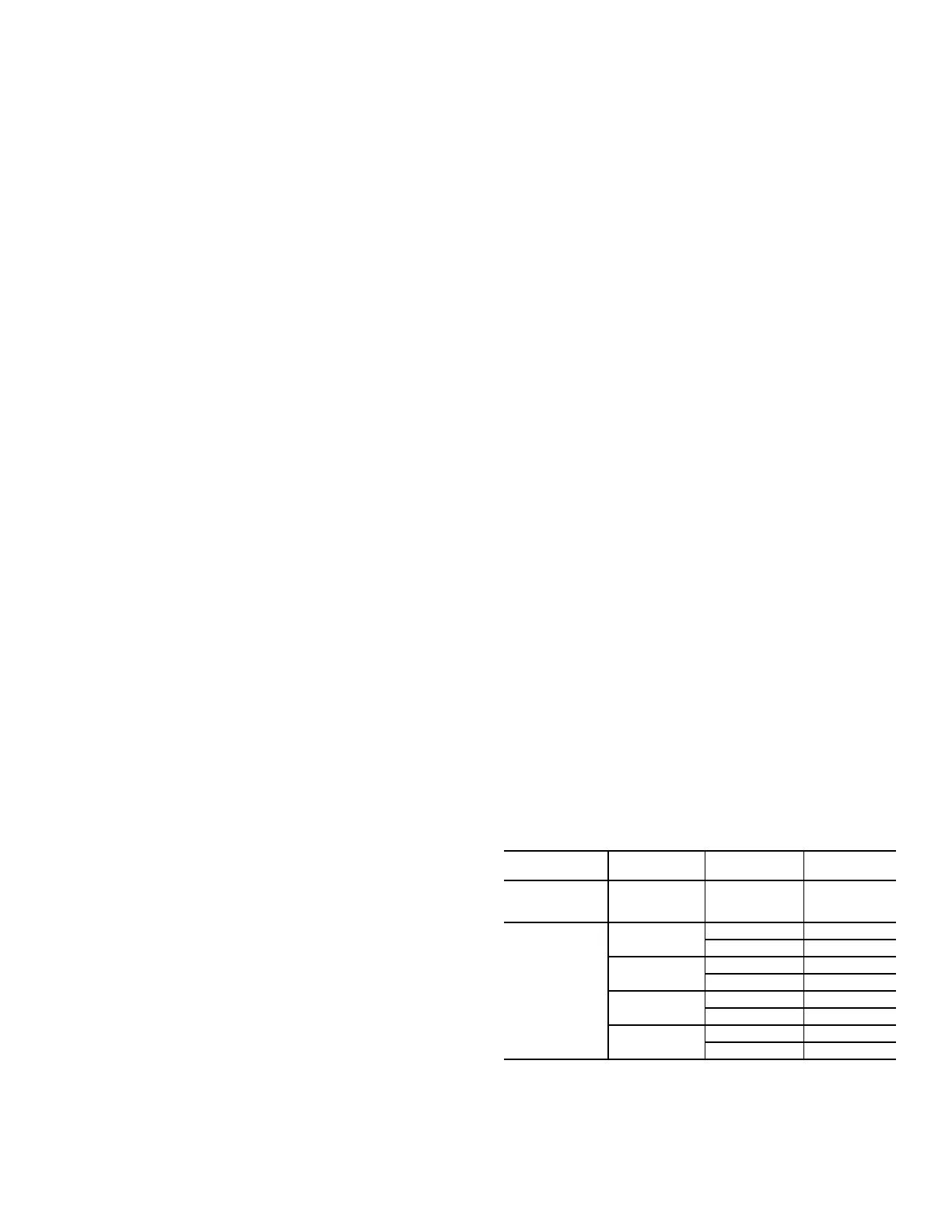